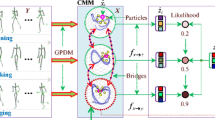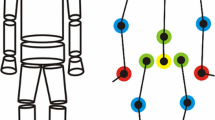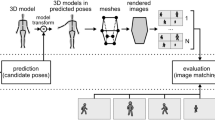Abstract
High dimensional pose state space is the main challenge in articulated human pose tracking which makes pose analysis computationally expensive or even infeasible. In this paper, we propose a novel generative approach in the framework of evolutionary computation, by which we try to widen the bottleneck with effective search strategy embedded in the extracted state subspace. Firstly, we use ISOMAP to learn the low-dimensional latent space of pose state in the aim of both reducing dimensionality and extracting the prior knowledge of human motion simultaneously. Then, we propose a manifold reconstruction method to establish smooth mappings between the latent space and original space, which enables us to perform pose analysis in the latent space. In the search strategy, we adopt a new evolutionary approach, clonal selection algorithm (CSA), for pose optimization. We design a CSA based method to estimate human pose from static image, which can be used for initialization of motion tracking. In order to make CSA suitable for motion tracking, we propose a sequential CSA (S-CSA) algorithm by incorporating the temporal continuity information into the traditional CSA. Actually, in a Bayesian inference view, the sequential CSA algorithm is in essence a multilayer importance sampling based particle filter. Our methods are demonstrated in different motion types and different image sequences. Experimental results show that our CSA based pose estimation method can achieve viewpoint invariant 3D pose reconstruction and the S-CSA based motion tracking method can achieve accurate and stable tracking of 3D human motion.

















Similar content being viewed by others
References
Agarwal A, Triggs B (2005) Monocular human motion capture with a mixture of regressors. IEEE Workshop on Vision for Human-Computer Interaction
Agarwal A, Triggs B (2006) Recovering 3-D human pose from monocular images. IEEE Trans Pattern Anal Mach Intell 28(1):44–58
CMU database. http://mocap.cs.cmu.edu/
de Castro LN, Von Zuben FJ (2002) Learning and optimization using the clonal selection principle. IEEE Trans Evol Comput 6(3):239–251
Deutscher J, Blake A, Reid I (2000) Articulated body motion capture by annealed particle filtering. In: Proceedings of IEEE Computer Society Conference on Computer Vision and Pattern Recognition, pp 126–133
Elgammal A, Lee C (2004) Inferring 3D body pose from silhouettes using activity manifold learning. In: Proceedings of IEEE computer society conference on computer vision and pattern recognition, pp 681–688
El-Nady KE, Abou El-Enien UH, Badr AA (2011) Why are clonal selection algorithms MCMC. Int J Open Probl Comput Math 4(3):37–55
Gong M, Jiao L, Zhang L (2010) Baldwinian learning in clonal selection algorithm for optimization. Inform Sci 180:1218–1236
Howe NR, Leventon ME, Freeman WT (2000) Bayesian reconstruction of 3D human motion from single-camera video. In: NIPS, pp 820–826
Isard M, Blake A (1998) Condensation: conditional density propagation for visual tracking. Int J Comput Vis 29(1):5–28
John V, Trucco E, Ivekovic S (2010) Markerless human articulated tracking using hierarchical particle swarm optimization. Image Vis Comput 28(11):1530–1547
Krzeszowski T, Kwolek B, Wojciechowski K (2010) Articulated body motion tracking by combined particles swarm optimization and particle filtering. In: Proceedings of international conference on Computer vision and graphics, pp 147–154
Lawrence ND (2003) Gaussian process latent variable models for visualization of high dimensional data. Advances in Neural Information Processing Systems (NIPS), pp 329–336
Lee C-S, Elgammal A (2010) Coupled visual and kinematic manifold models for tracking. Int J Comput Vis 87(1):118–139
Moeslund TB, Hilton A, Kruger V (2006) A survey of advances in vision-based human motion capture and analysis. Comput Vis Image Und 104(2):90–126
Mori G, Malik J (2006) Recovering 3D human body configurations using shape contexts. IEEE Trans Pattern Anal Mach Intell 28(7):1052–1062
Ormoneit D, Sidenbladh H, Black MJ, Hastie T (2001) Learning and tracking cyclic human motion. Advances Neural Info Process Systs 13:894–900
Poppe R (2007) Vision-based human motion analysis: an overview. Comput Vis Image Und 108(1):4–18
Raskin L, Rudzsky M, Rivlin E (2011) Dimensionality reduction using a Gaussian Process Annealed Particle Filter for tracking and classification of articulated body motions. Comput Vis Image Und 115(4):503–519
Sigal L, Black MJ (2010) HumanEva: synchronized video and motion capture dataset for evaluation of articulated human motion. Int J Comput Vis 87(1):4–27
Sminchisescu C (2007). 3D human motion analysis in monocular video, techniques and challenges. In: Kleete R, Metaxas D, Rosenhahn B (eds) Human motion understanding, modeling, capture and animation. Springer-Verlag
Sminchisescu C, Jepson AD (2004) Generative modeling for continuous non-linearly embedded visual inference. In: Proceedings of the international conference on machine learning, pp 759–766
Sminchisescu C, Triggs B (2003) Estimating articulated human motion with covariance scaled sampling. Int J Robot Res 22(6):371–392
Tenenbaum JB, de Silva V, Langford JC (2000) A global geometric framework for nonlinear dimensionality reduction. Science 290(22):2319–2323
Tian T-P, Li R, Sclaroff S (2005) Tracking human body pose on a learned smooth space. Technical Report BUCS-TR-2005-029, Boston University, Computer Science Department, Boston, MA, July 2005
Urtasun R, Fleet D, Fua P (2005) Monocular 3-D tracking of golf swing. In: Proceedings of IEEE Computer Society Conference on Computer Vision and Pattern Recognition, pp 932–93
Zhang X, Hu W, Maybank S, Xi L (2008) Sequential particle swarm optimization for visual tracking. In: Proceedings of IEEE Computer Society Conference on Computer Vision and Pattern Recognition, pp 23–28
Zhao X, Liu YC (2008) Generative tracking of 3D human motion by hierarchical annealed genetic algorithm. Pattern Recognit 41(8):2470–2483
Acknowledgements
This work is supported by The National High Technology Research and Development Program of China (2007AA01Z334), National Natural Science Foundation of China (61272219, 61021062 and 61100110), Program for New Century Excellent Talents in University of China (NCET-04-04605), Natural Science Foundation of Jiangsu Province (BK2010375), Key Technology R&D Program of Jiangsu Province (BY2012190, BE2010072 and BE2011058).
Author information
Authors and Affiliations
Corresponding author
Rights and permissions
About this article
Cite this article
Li, Y., Sun, Z. Generative tracking of 3D human motion in latent space by sequential clonal selection algorithm. Multimed Tools Appl 69, 79–109 (2014). https://doi.org/10.1007/s11042-012-1251-5
Published:
Issue Date:
DOI: https://doi.org/10.1007/s11042-012-1251-5




